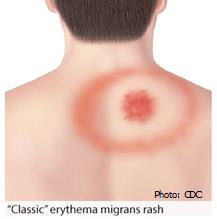Tickborne Diseases in Arkansas
RMSF | Ehrlichiosis | Anaplasmosis | Tularemia | Lyme Disease |
STARI | Heartland Virus | Bourbon Virus
Rocky Mountain Spotted Fever
Rocky Mountain spotted fever (RMSF) is the most common tick-borne disease in Arkansas. RMSF is caused by the bacterium Rickettsia rickettsii. This bacterium is carried mostly by the American dog tick, Dermacentor variabilis, but also by the brown dog tick, Rhipicephalus sanguineus. Scientists are discovering more and more of rickettsial organisms infecting ticks, many of which also cause disease in people and animals. In response to these discoveries, the medical community has grouped the infections and now generally calls them Spotted Fever Rickettsioses. Not all ticks are infected with disease-causing bacteria. It takes an infected tick four to six hours or more to spread the disease after attaching to the host. Adult ticks look for large hosts such as dogs, but they also feed on humans. Ticks are often found in overgrown lots and along weedy roadsides, paths, and hiking trails. Most RMSF cases occur between June and August when tick populations and outdoor activities are highest. Half of all people with RMSF do not remember being bitten by a tick.
- RMSF Symptoms and Treatment
- Symptoms of RMSF generally appear suddenly, about one week after an infected tick bite. However, there may be symptoms any time between 2 and 14 days after a bite.
- Symptoms can include:
- High fever
- Headache
- Muscle pain
- Non-itchy, pink rash usually starting on the wrists, forearms, and ankles
It is important to get medical care as soon as possible if you think you have RMSF. Blood tests are required to diagnose RMSF, but treatment should begin as soon as symptoms and/or recent tick exposure suggest RMSF.
More information can be found on the CDC website for Rocky Mountain spotted fever.
Ehrlichiosis
Ehrlichiosis is the name used to describe several bacterial diseases that affect animals and humans. Human ehrlichiosis (formerly called human monocytic ehrlichiosis or HME) is caused by Ehrlichia chaffeensis (first recognized in 1986 from a patient infected at Fort Chaffee, AR) and Ehrlichia ewingii. Ehrlichiosis and Anaplasmosis have similar clinical presentations, but they are transmitted by two different species of ticks and generally occur in different regions of the U.S. Ehrlichiosis is most frequently reported from the southeastern and south-central regions of the U.S., and from the eastern seaboard extending westward to Texas. The areas from which cases are reported correspond with the known geographic distribution of the Lone Star tick (Amblyomma americanum), which is associated with the transmission of both E. chaffeensis and E. ewingii. Three states - Oklahoma, Missouri, and Arkansas - account for 35% of all reported E. chaffeensis infections.
Ehrlichiosis Symptoms and Treatment
Symptoms may appear up to 10 days after a tick bite.
- Fever
- Headache
- Chills
- Malaise
- Myalgia
- Gastrointestinal symptoms such as nausea, vomiting, diarrhea, and anorexia
- Confusion
- Conjunctival injection
- Rash (more commonly reported among children)
Anaplasmosis, ehrlichiosis, and Rocky Mountain spotted fever are treated in the same manner with doxycycline. Clinical suspicion of any of these diseases is sufficient to begin treatment. Delay in treatment may result in severe illness and death.
More information can be found on the CDC website for ehrlichiosis.
Anaplasmosis
Anaplasmosis is a tick-borne disease caused by the bacterium Anaplasma phagocytophilum. It was previously known as human granulocytic ehrlichiosis (HGE). Anaplasmosis is spread to humans by tick bites primarily from the blacklegged tick, Ixodes scapularis. Anaplasmosis is most frequently reported from the upper midwest and northeastern U.S., in areas that correspond with the known geographic distribution of Lyme Disease. In Arkansas, these ticks are commonly found in shady areas along roads, meadows and woods. The risk of picking up these ticks is greater in wooded or brushy areas and in the edge area between lawns and woods.
Anaplasmosis Symptoms and Treatment
Symptoms may appear up to 10 days after a tick bite.
- Fever, shaking, chills
- Severe headache
- Malaise
- Myalgia
- Gastrointestinal symptoms such as nausea, vomiting, diarrhea, and anorexia
- Cough
- Rash (rare cases)
Anaplasmosis, ehrlichiosis, and Rocky Mountain spotted fever are treated in the same manner with doxycycline. Clinical suspicion of any of these diseases is sufficient to begin treatment. Delay in treatment may result in severe illness and death.
More information can be found on the CDC website for anaplasmosis.
Tularemia is a disease of animals and humans caused by the bacterium Francisella tularensis. Rabbits, hares and rodents are especially susceptible and often die in large numbers during outbreaks. Humans can become infected through several routes, including:
- Tick bites, including the American dog tick, Dermacentor variabilis, and the lone star tick, Amblyomma americanum
- Deer fly bites
- Skin contact with infected animals, especially hunting and skinning infected rabbits
- Ingestion of contaminated water
- Inhalation of contaminated dust or aerosols
- Contact as a result of bioterrorism
Tularemia Symptoms and Treatment
Symptoms vary depending on the route of infection. Although tularemia can be life-threatening, most infections can be treated successfully with antibiotics. Reduce the risk of getting tularemia by following these steps:
- Use an insect repellent
- Wear gloves when handling sick or dead animals
- Avoid mowing over dead animals
More information can be found on the CDC website for tularemia.
Lyme Disease
Lyme disease is caused by the bacterium Borrelia burgdorferi, and it is transmitted to humans and animals through the bite of infected black-legged ticks (Ixodes scapularis).
According to the CDC case definition for Lyme disease, Arkansas is considered a low-incidence state, meaning there are less than 10 confirmed cases per 100,000 people for the previous three reporting years. Ninety-five percent (95%) of Lyme disease cases come from 14 states. They are concentrated heavily in the Northeastern, Mid-Atlantic, and upper Midwestern states. Verified cases reported from other US states are usually associated with travel to states with high rates of infection. Lyme disease testing and interpretation is complicated. CDC currently recommends a two-step process when testing blood for evidence of antibodies against the Lyme disease bacteria. Both steps can be done using the same blood sample. The two steps of Lyme disease testing are designed to be done together. CDC does not recommend skipping this process as doing so will increase the frequency of false positive results and may lead to misdiagnosis and improper treatment. Some laboratories offer Lyme disease testing using assays whose accuracy and clinical usefulness have not been adequately established. Newer tests may be developed as alternatives to one or both steps of the two-step process. Still, before CDC will recommend new tests, their performance must be demonstrated to be equal to or better than the results of the existing procedure, and they must be FDA-approved.
Northern vs. Southern I. scapularis
| Northern | Southern | Reference | |
| Found on humans? | Frequently | Rarely | Stromdahl and Hickling 2012 |
| Collected by drag sampling | Frequently | Rarely | Diuk-Wasser et al. 2006 |
| Most common host of larvae | Mice | Lizards | Apperson et al. 1993 |
| Questing behavior | On stems | In leaf litter | Arsnoe et al. 2015 |
For more information, click here to view our Grand Rounds presentation "Does Arkansas Have Lyme Disease?"
Symptoms:
- Fever
- Headache
- Fatigue
- A characteristic skin rash called erythema migrans (bulls-eye)

For Health Care Professionals: Diagnosis, Treatment, and Testing
- CDC: Two-step Laboratory Testing Process - Describes the steps to properly test for Lyme disease; includes decision tree.
- Treatment guidelines
- CDC: Tests that are NOT recommended by CDC for Lyme disease
- CDC: Understanding Test Results for Infectious Diseases
Because Arkansas is categorized as a low-incidence state, healthcare professionals should consider other diagnosis first, like: viral infections, STARI, fibromyalgia, or arthritis.
More information can be found on the CDC website for Lyme Disease.
A rash similar to the rash of Lyme disease has been described in humans following bites of the lone star tick, Amblyomma americanum. The rash may be accompanied by fatigue, fever, headache, muscle and joint pains. This condition has been named southern tick-associated rash illness (STARI). The cause of STARI is not known.
More information can be found on the CDC website for STARI.
Emerging Tickborne
Heartland VirusHeartland virus is believed to be spread to people by infected ticks. Cases of Heartland virus have been identified in the Midwestern and southern United States, including Arkansas. Scientific investigations are underway to find out if a bite from an infected tick is how people get Heartland virus illness. Recent studies have shown that the Lone Star tick (Amblyomma americanum) can transmit the virus.
In general, people identified with Heartland virus infection have suffered a flu-like illness in the months of May to September. They all had a fever, experienced fatigue, and loss of appetite. Some also complained of headaches, muscle and joint aches, diarrhea, or feeling sick to their stomach. There are no vaccines to prevent or medications to treat Heartland virus infections. Most Heartland virus patients required hospitalization but were able to return to their normal health in the weeks and months following their discharge.
Bourbon Virus
Bourbon virus was recently discovered in Bourbon County, Kansas. Only a few cases have been identified so scientists are still learning about possible symptoms caused by this new virus, and how people become infected with it. However, based on what we know about similar viruses, it is likely that Bourbon virus is spread thorugh tick or other insect bites.
People diagnosed with Bourbon virus had symptoms including fever, fatigue, rash, headache, other body aches, nausea, and vomiting. They also had low blood counts for cells that fight infection and help prevent bleeding. There are no vaccines to prevent or medications to treat Bourbon virus infections.
More information can be found on the CDC website for Bourbon virus and the Heartland and Bourbon virus page.


